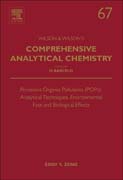
Persistent Organic Pollutants (POPs): Analytical Techniques, Environmental Fate and Biological Effects
Zeng, Eddy Y
This book focuses on those organic chemicals that are regulated by the Stockholm Convention on Persistent Organic Pollutants (POPs). as well as organic chemical with the attributes of being persistent, bioaccumulative, and toxic to ecosystem and human beings, criteria used by the Stockholm Convention for screening POP candidates. Because of the unfavourable properties of POPs, numerous research efforts have been directed toward investigating their input sources, fate, and effects, with the help of continuously improving analytical technologies. The contributors to this book provide an integrated assessment of existing data, which will benefit both the scientific and management communities in planning further research projects and/or pollution control measures. Comprehensive overview of recent advances in analyzing persistent organic pollutants (POPs)Covers input sources, fate and biological effects of POPsContains essential information for environmental management INDICE: 1. Analytical methods for measurement of legacy and emerging POPs in complex sample matrices, Ying Guo and Kurunthachalain Kannan 2. Bioanalytical approaches to understand the toxicological implications of mixtures of POPs in marine wildlife, Ling Jin, Caroline Gaus, and Beate Escher 3. Fast analytical techniques based on microextraction, Ruifen Jiang and Gang-Feng Ouyang 4. Field application of passive sampling techniques in measurement of POPs in aquatic environments, Lian-Jun Bao and Eddy Y. Zeng 5. Assessment of sediment toxicity with SPME-based approaches, Jing You, Huizhen Li, and Michael J. Lydy 6. Sources, fate and removal of pharmaceutical and personal care products (PPCP) from wastewaters, Cristina Ávila and Joan Garcia 7. Atmospheric deposition of POPs: Implications for the chemical pollution of aquatic environments, Javier Castro-Jimenez, Jordi Dachs and Steven J. Eisenreich 8. E-waste: a new source of emerging organic contaminants, Hong-Gang Ni and Eddy Y. Zeng 9. Occurrence and human health risk of emerging organic contaminants in e-waste, David O. Carpenter 10. Long-range and regional atmospheric transport of POPs and implications for global cycling, Kimberly J. Hageman, Christian Bogdal and Martin Scheringer 11. Occurrence and fate of PPCPs in wastewater, Trine Eggen 12. Occurrence and ecological risk of emerging organic contaminants in coastal zones, Paul K.S. Lam 13. Atmospheric long-range transport of persistent organic pollutants into Polar regions: distribution and fate, Roland Kallenborn and Hayley Jung 14. Bioaccumulation and biotransformation of BFRs, Alin Dirtu, Liesbeth Weijs, Govindan Malarvannan and Adrian Covaci 15. Bioavailability of POPs in soil/sediment: concept, analytical tools and applications in risk assessment, Kirk T. Semple 16. Benzotriazoles: history, environmental distribution, geochemistry, and potential ecological effects, Mark G. Cantwell, Julia C. Sullivan, and Robert M. Burgess 17. QSARs on the thyroid hormone effects of polybrominated diphenyl ethers (PBDEs) and related compounds, Fei Li, Xianhai Yang, Jingwen Chen, and Felichesmi Lyakurwa 18. The toxicity of Persistent Organic Pollutants to aquatic organisms, S. Michele Harmon 19. Health-based risk assessment of PBDEs, Li Chen, Lucy Li, Yunhui Zhang
- ISBN: 978-0-444-63299-9
- Editorial: Elsevier
- Encuadernacion: Cartoné
- Páginas: 650
- Fecha Publicación: 01/03/2015
- Nº Volúmenes: 1
- Idioma: Inglés
